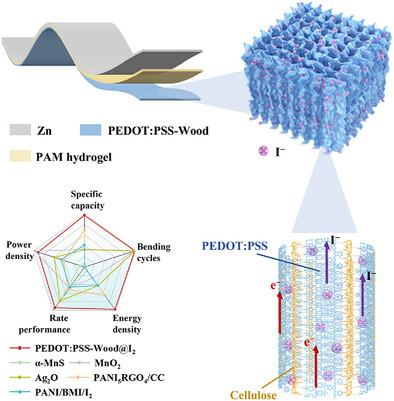Highly Flexible and Structurally Stable Oriented Conductive Framework for Deformation-Tolerant Zn-Ion Batteries
IF 19
1区 材料科学
Q1 CHEMISTRY, MULTIDISCIPLINARY
引用次数: 0
Abstract
Oriented conductive frameworks with high flexibility and mechanical stability can facilitate efficient electron and ion transport in complex-shaped power supplies, boosting the reliability and function of the next-generation flexible electronics. Here, a multi-direction deformable and structurally stable oriented conductive framework is presented, which is mediated by hydrogen bonding interactions of poly(3,4-ethylenedioxythiophene)-poly(styrenesulfonate) (PEDOT:PSS), through self-assembly on a porous wood template. The framework exhibits excellent flexibility in three dimensions, restoring integrity and maintaining constant conductivity across diverse deformations, even after enduring 5000 bending cycles (angle: 180°) and soaking in water for 6 months. Utilizing its unique oriented structure and flexible bending capability, a flexible zinc-iodine battery is developed, which demonstrates a high areal capacity of 3.2 mAh cm−2 and an energy density of 3.8 mWh cm−2. Moreover, the battery is capable of high-current charging and discharging at 20 mA cm−2, with an impressive areal capacity of 1.9 mAh cm−2, far superior to the existing flexible zinc-ion batteries. It also demonstrates excellent electrochemical and mechanical stability under various deformations, including bending, twisting, and rolling, providing stable energy for a commercial toy car and a flexible screen even under hammer strikes and repeated bending. This work advances the development of high-performance, deformation-tolerant, flexible batteries.

高柔性和结构稳定取向导电框架的耐变形锌离子电池
具有高柔性和机械稳定性的定向导电框架可以促进复杂形状电源中有效的电子和离子传输,提高下一代柔性电子产品的可靠性和功能。本文提出了一种多向可变形且结构稳定的定向导电框架,该框架由聚(3,4-乙烯二氧噻吩)-聚苯乙烯磺酸盐(PEDOT:PSS)的氢键相互作用介导,通过在多孔木模板上自组装而成。该框架在三维空间中表现出出色的灵活性,即使在经历5000次弯曲循环(180°角度)和水中浸泡6个月后,也能在各种变形中恢复完整性并保持恒定的导电性。利用其独特的定向结构和柔性弯曲能力,研制出了一种柔性锌碘电池,该电池具有3.2 mAh cm - 2的高面容量和3.8 mWh cm - 2的能量密度。此外,该电池具有20ma cm - 2的大电流充放电能力,面积容量达到1.9 mAh cm - 2,远远优于现有的柔性锌离子电池。它在弯曲、扭曲和滚动等各种变形下也表现出优异的电化学和机械稳定性,即使在锤击和反复弯曲的情况下,也能为商用玩具车和柔性屏幕提供稳定的能量。这项工作推动了高性能、抗变形、柔性电池的发展。
本文章由计算机程序翻译,如有差异,请以英文原文为准。
求助全文
约1分钟内获得全文
求助全文
来源期刊

Advanced Functional Materials
工程技术-材料科学:综合
CiteScore
29.50
自引率
4.20%
发文量
2086
审稿时长
2.1 months
期刊介绍:
Firmly established as a top-tier materials science journal, Advanced Functional Materials reports breakthrough research in all aspects of materials science, including nanotechnology, chemistry, physics, and biology every week.
Advanced Functional Materials is known for its rapid and fair peer review, quality content, and high impact, making it the first choice of the international materials science community.
 求助内容:
求助内容: 应助结果提醒方式:
应助结果提醒方式:


